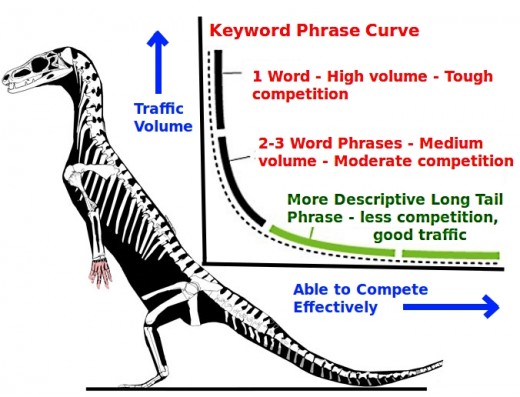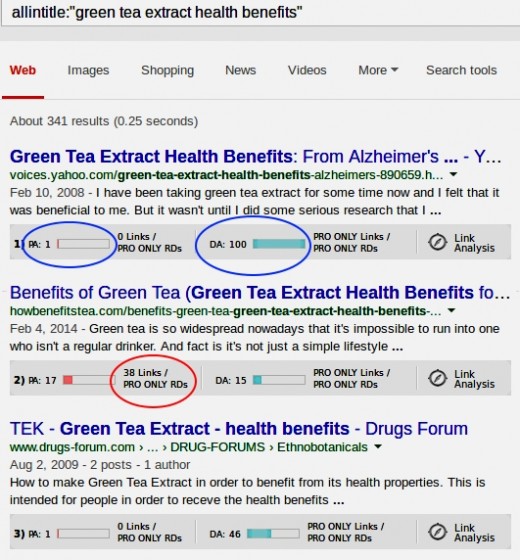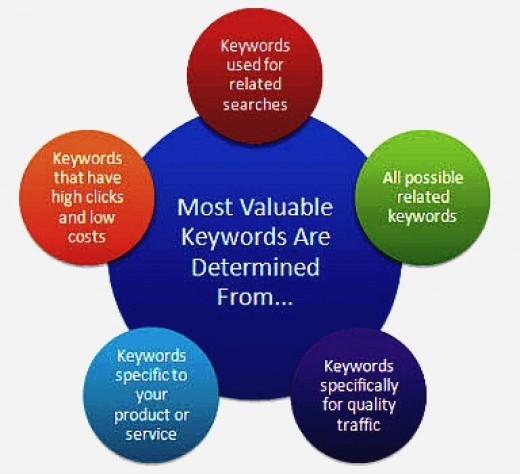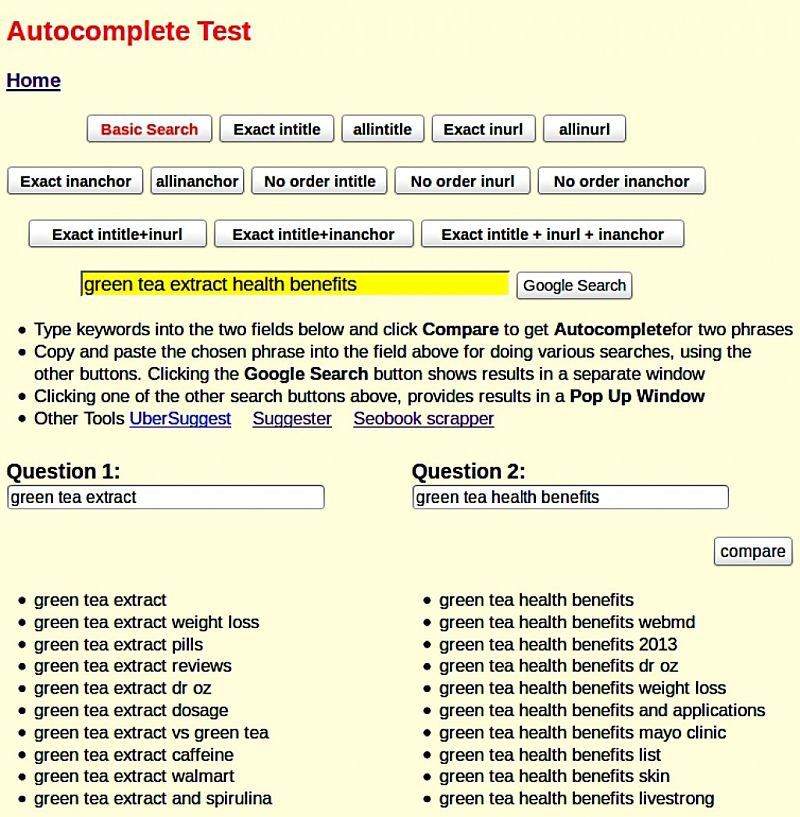Find Two-Phrase Long Tail Keywords for Competitive Titles
One of the hardest tasks for ensuring your articles are found, and are read many times, through being listed in the top 10 search engine results (SERPS), is picking competitive keywords and phrases for your titles and topics.
If you pick popular phrases, for which over a million pages have been written previously, then you are unlikely to be listed high enough to get traffic. This is the modern equivalent of the 'Tragedy of the Commons'.
Writers spend hours and hours, crafting magnificent gems of creative writing that no one will ever see. This is simply because their titles and topics are in saturated areas, in which they have no hope of competing, and getting any traffic.
There are many keyword tools available, some costing hundreds of dollars a month for subscriptions, but they all have their flaws. Most are very optimistic in their predictions or are just plain wrong. The proof is in the pudding - predicting traffic is very difficult and most tools are unreliable and expensive.
Many people use Google Keyword Planner(Google Adwords Keyword Planner).But it is designed for selecting words for adsense campaigns rather than choosing competitive keywords. The parameters for this tool keeps changing. It is difficult to use and understand its outputs.
Very few know how to use it successfully and it takes a lot of manipulations and analysis of the data in spreadsheets, etc. There has to be a simple free way of doing this using Google Search itself.
This article describes a free method for choosing two or more phrases to develop long tail titles, that have a good chance of being competitive and providing a good chance of success.

Semantic Search Why it Matters - The Hummingbird Algorithm
Semantic search lies at the heart of Google's Knowledge Graph tool, which is part of Google's trajectory to answer queries just like the “Star Trek Computer” or HAL.
Google’s new Hummingbird algorithm applies similar principles to the SERPS. The aim is to guess or predict the user intent by interpreting the entire query as phrases, not just the individual keywords itself. This means that the whole phrase meaning is taken into account to deliver pages matching that meaning, rather than pages that match just a few words.
Before - A Search for “athlete's foot prescription” gave a list drugs for this affliction
After - Search results show listings about treatments in general, including non-drug ones and preventative methods.
But the search results can be more specific as well by better predicting what the answers a used was suggesting.
Before - A Search for “pizza heaven calories per slice” used to list general answers about pizza and calories
After - Search Results show listing directly from Pizza Heaven itself and other site that list this specific information.
The Power of the Auto Suggest (Auto Complete) Tool
When you enter words into Google, the Auto Suggest tool starts to provide search suggestions in a text box below the main search window. You can then click on one of the choices to run a suggested search.
These are all real searches that have been done by other people. The search queries that you see as part of Auto Complete are a reflection of the past search activity of users and the content of web pages indexed by Google.
They may also be influenced by related searches you’ve done in the past and Google+ profiles. Popularity is a major factor.
But the key point is that what are shown are exact phrases that have been searched for many times in the past. The listings also appear to be listed in terms of frequency of occurrence.
For certain searches, Google shows predictions for extra words. Once again these phrases are ones that have been typed before by Google users or appears frequently on the web.
This is a treasure trove for key word selection and optimization for the following reasons:
► The phrases are the most popular ones
► The phrases are more likely to be selected by users who see the predictions and click on the phrase to do the search
► The display highlights the way most people search with the most important word first. This means that people seldom search for "how to boil an egg" - with the 'egg' buried in the phrase, but search for 'boiling and egg' or even 'egg boiling'.
While the autocomplete results will often add the 'How to' the keyword 'boiling' is very different from 'boil'.
The key message here is that the more important words should be placed towards the beginning of the phrase for more effective listing in the SERP results. This is the way most people look for answers.
The negative aspect of Auto Suggest is that the phrases are the most popular ones and so are more likely to be uncompetitive - they will be thousands or millions of websites that deliver information on these phrases.
However as you build a phrase the number of results tends to diminish and this is the principle of the long tail search expressions. This simply means being more and more specific to narrow down the competition.
Long Tails - Why They Work
Long-tail keywords were promoted, long ago, as a great way to find competitive keyword phrases that helped you get a high position in the SERPS and so to get good traffic. Good rankings were easier to achieve with more specific and narrower searches. Competition was lower, and it was easier to optimize titles and contents pages by targeted such keyword phrases.
As the image above shows, there is a trade off between expected traffic and being able to compete by lowering the number of pages competing for the same phrase.
The move towards semantic search has renewed the interest in long-tail keywords and this tactic.
Google will rank pages for the whole phrase, and for all of the word combinations it contains.
This provides extra opportunities to get traffic.
So for a long tail keyword phrase 'green tea extract health benefits' Google will rank the page for each individual word as well , for example:
► Green tea,
► Green tea extract,
► Tea extract,
► Green tea health,
► Health benefits of green tea, etc.
As the phrase is lengthened the search becomes more specific and there are fewer pages competing for the complete phrase.
For an exact allintitle search (where the exact phrase occurs in the title) the number of pages listed by Google are:
Green tea ► 510,000
Green tea extract ► 59,600
Tea extract ► 76,600
Green tea health ► 5,480
Health benefits of green tea ► 3,480
Green tea extract health benefits ► 341
The other aspect, is that you may get traffic from the secondary phrase as well as the primary one. Keyword selection and optimization is far from an exact science. You may get more traffic from the phrase "Health benefits of green tea" rather than the primary one chosen - "Green tea extract health benefits". So it pays to consider this.
The other aspect of long tail keywords is that the topics are far more specific and so more relevant to what the searcher is looking for. This can lead to higher engagement and higher conversion rates for sales and clicks.
The trade-of is that there is
>a penalty for increasing the number of keywords as it dilutes and lowers the weight and rankings applied to each keyword.
The Power of Twin, and Multiple Keyword Phrases
Developing the argument about the benefits of long tail keywords to the next stage involves researching not one but two or three competitive phrases and including these in the titles.
If you can craft your title to include two competitive phrases it is more likely that one of them will deliver traffic. It is worthwhile doing the extra research for this.
Knowing the Strength of Who You are Competing Against
Being competitive means not only having few competitors, but knowing the strengthof the pages you will be competing against.
Once again this is not an exact science.
However, the basic principle is to get a measure of page and author authority or Google's page rank, and the number of links for the page. there are also other things to see by simply opening the pages in the top three SERP positions.
The free MOZ bar addon for Mozilla and Chrome adds a summary to each item in the search results that displays the following:
► PA - Page Authority
► Number of Links
► DA - Domain Authority
Mox Addon Tool Summary for Each Search Result

Examining these summaries for the top 3-6 search results provides a good indication of the strength of your competitors
Output from an allintitle exact search showing the MOZ tool summary

Predicting Success of Long Tail Keyword Titles and Topics
This is the hardest part of the deal. Many expensive tools such as Jaaxy provide estimates of the expected number of pages competing for an exact search for each of the keyword suggestions it provides. They also provide estimates of traffic for a site in the number one position and the KQI (keyword quality indicator or score) which predicts the likelihood of success.
You can get an indication using the MOZ bar tool and by conducting special searches that Google provides to identify your likely competitors. [Note: Do not put a space before the keyword phrase].
► allinttitle: Searches for pages containing ALL the keywords you specify in the title.
For example: allintitle:green tea extract will list pages that have ALL three keywords in any order or position.
► allinanchor: Searches for pages containing ALL the keywords in the phrase you specify in the anchor text on links to the page.
► allinurl: Searches for pages containing ALL the keywords you specify in the URL
► intitle: Searches for pages containing ANY of the individual keywords in the phrase you specify in the page title.
► inanchor: Searches for pages containing ANY of the individual keywords in the phrase you specify in anchor text for links to the page.
► inurl: Searches for pages containing ANY of the individual keywords in the phrase you specify in the URL.
Exact Searches - You can do any of these searches using exact phrases by enclosing the term in quotes - e.g. allintitle:"green tea extract" will restrict the search to this exact phrase and word order.
A Great Tool to Do This Research - The Autocomplete Test Tool
There is a great free tool which helps you research two-phrase keywords for titles using these methods - The Autocomplete Test Tool.
Two searches can be done simultaneously for auto suggestions, using two search boxes.
You can then plug a full phrase into another field and use buttons to run any of the specials searches listed above to check out the competition.
This makes the job easier and its completely free! Give it a try. A screen shot is provided below.



